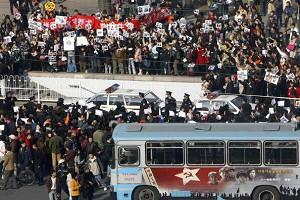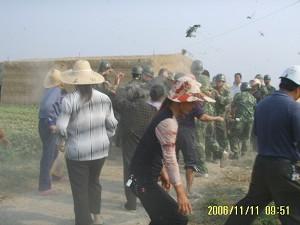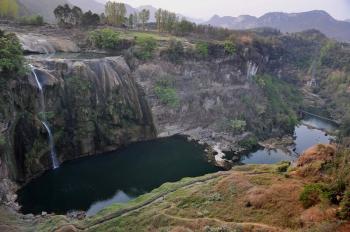CHINA—In the past week, several large-scale protests have erupted in China. From November 8-16, there were at least six incidents of group protests with tens of thousands of people.
The reasons for the protests include land seizures without payment, compulsory removal of dogs, and medical malpractice. News agencies such as AP, Reuters, AFP, BBC, New York Times, Washington Post, and The Guardian have all conducted interviews or in-depth reports on these incidents, which occurred in Fujian, Jinan, Guangdong, and Sichuan provinces and Beijing.
As the Chinese Communist Party (CCP) promotes the “harmonious society” on the one hand, it intensifies its use of force to suppress protestors on the other hand. Recently, Beijing announced the Preliminary Proposal to implement the Military to Manage Emergency Situation plan, which authorizes the military to support the suppression of group protests.
This proposal, announced by the Central Military Commission, defines five types of serious incidents the military should become involved in:
1. Manage military conflict incidents
2. Assist local authorities to stabilize society
3. Manage serious terrorist events
4. Aid in disasters
5. Manage incidents that are in violation of public security.

The regime’s mouthpiece Xinhua News Agency, reported that the proposal is the first regulation that the regime has made for the military to manage emergencies. It provides effective rules for the military to function in these incidents.
However, analysts said the so-called agenda “to assist to stabilize local society and handle incidents in violation of public security” is in fact a front to suppress the nation’s group protests.
In recent years, Chinese society has become more unstable with escalating group protests. The regimes official reports indicate there were 87,000 group protests in China in 2005 and the number of participants exceeded 3.76 million. The following represent several major recent clashes between the people and local government security forces.
Over One Thousand Armed Police Entered Dongzhou Village in Shanwei City
On Nov 10, in Dongzhou Village, Shanwei City, Guangdong Province, over 2,000 villagers protested in front of the village office asking the authorities to release their representative Chen Qian. The villagers took eight staff members under house arrest after not receiving any response from the authorities.
On Nov 16, the Shanwei City authorities sent over 1,000 armed police, public security agents, fire fighters, and officials to be stationed in Dongzhou Village. This incident is the direct result of the Shanwei Massacre which occurred on December 6, 2005.
Bloody Conflict in Putian City, Fujian Province
On Nov 12, 2005, farmers from Xindu Town, Putian City, Fujian Province, protested about the forced land expropriation for the building of a power plant. Over a hundred armed police were dispatched to suppress the villagers. About a dozen villagers were admitted to the hospital, including a 55-year-old person in critical condition who required head surgery.
Conflict in Jinan City, Shandong Province
The South China Morning Post , a Hong Kong-based English-language newspaper, quoted a witness saying that about 1,400 police and 1,000 farmers broke into a conflict several days ago in Zhangjia Village, Jinan City, Shandong Province. Over 20 villagers were injured by the police and seven arrested because of the forced land expropriation.
Over Ten Thousand People Surrounded Officials in Shunde City, Guangdong Province
Guangdong is one of the provinces with the most serious land expropriation embezzlements. Protests from the farmers never stop. On Nov 8, 2006, in Sanzhou Village, Shunde City, which is located 15 miles south of Guangzhou City, over 10 thousand villagers besieged 300 local officials and overseas Chinese businessmen overnight. The Guangdong authority mobilized over 1000 riot police to disperse the villagers.
Removal and Disposal of Pet Dogs in Beijing Results in a Large-Scale Protest
On Nov 11, 2006, hundreds of anti-riot police clashed with dog lovers in Beijing.
Since the end of October, the Beijing municipal authority started to remove many dogs with the excuse of rabies prevention. Large breeds were banned in Beijing. Dogs taller than 14 inches would be removed and killed. One household can only have one dog; the second one would be removed. Many dog lovers started to protest. On the November 11, the protest in front of the Beijing Zoo lasted for three hours. Hundreds of anti-riot police dispersed the protestors from the scene.
This was one of the rarely seen large-scale spontaneous gatherings in Beijing. News agencies such as AP, Reuters, BBC, and media from Taiwan and Hong Kong reported on this incident. However, the local Beijing media did not report the incident.
Medicinal Malpractice in Sichuan Province Results in Conflicts Between Civilians and the Police
In Guang‘an City, Sichuan Province, a three-year-old boy named Xiong Honghui accidentally ingested pesticide and was taken to the Gaung’an City Second People’s Hospital. The hospital refused to provide the boy necessary treatment because the family did not bring enough cash with them. The boy died as the family was collecting money.
On November 12, 2006, about 2,000 civilians gathered in front of the Gaung‘an City Second People’s Hospital to demand the hospital accept responsibility for the boy’s death. Hundreds of police went to disperse the protesters. The incident turned into a large-scale conflict between the civilians and the police. About ten people were injured and five arrested by the police. A few police cars were set on fire. Later the Beijing authorities sent the military and bulletproof military cars into Guang’an City to patrol the streets with armed police.




Friends Read Free